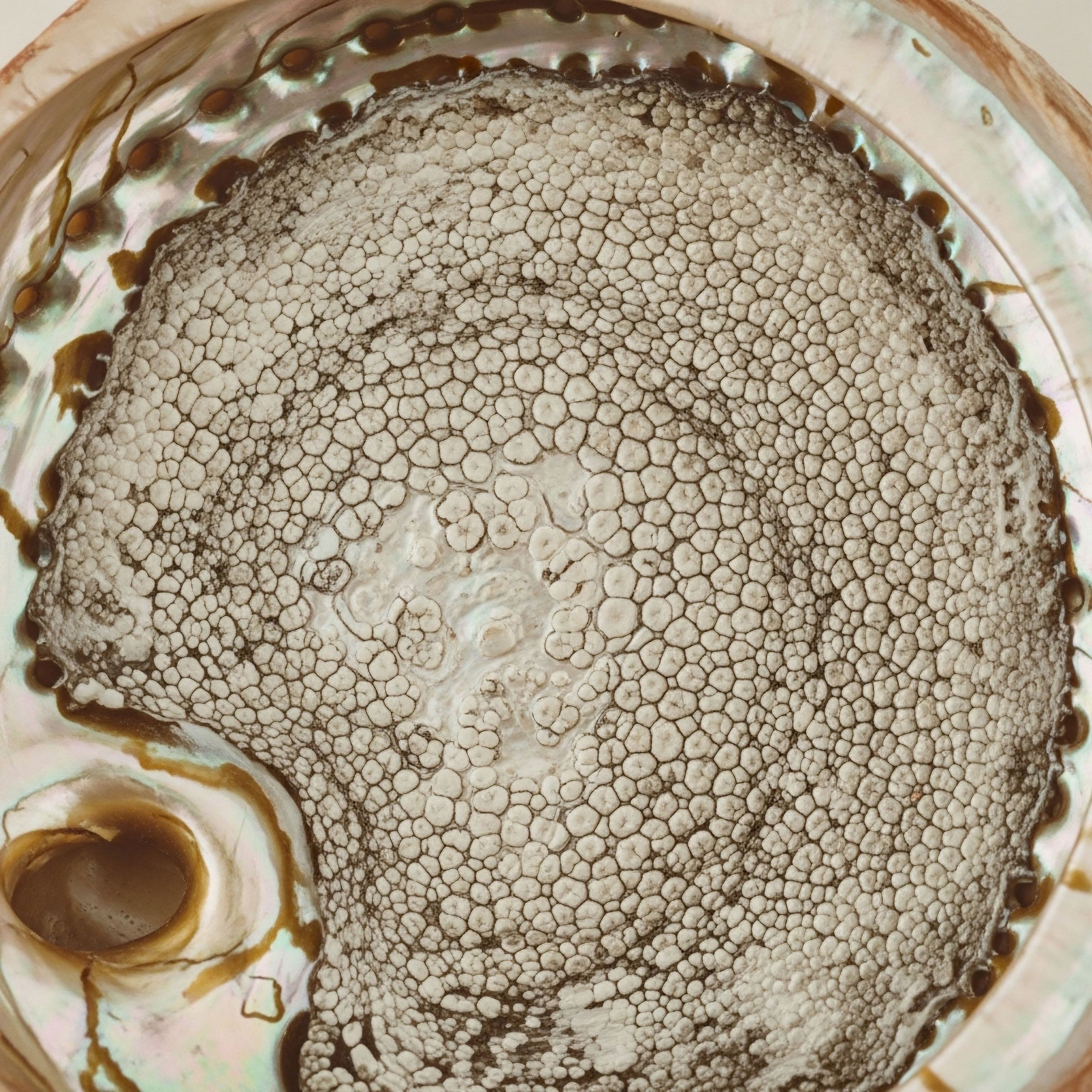

Fundamentals
Have you ever experienced a subtle yet persistent feeling of sluggishness, a sense that your body’s internal currents are moving with a newfound resistance? Perhaps you’ve noticed a diminished exercise capacity, or a general feeling of being “off,” even when other health markers appear within normal ranges.
This experience, often dismissed or attributed to the demands of modern life, can sometimes point to a deeper physiological imbalance. It speaks to the intricate dance of your biological systems, particularly the endocrine network, which orchestrates countless functions, including the very viscosity of your blood.
Our bodies are remarkable self-regulating systems, constantly striving for equilibrium. When we consider the fluid dynamics within our circulatory system, a critical component is the hematocrit, which represents the proportion of red blood cells in your total blood volume.
These red blood cells, laden with oxygen-carrying hemoglobin, are vital for delivering life-sustaining energy to every tissue and organ. However, when their concentration becomes excessively high, the blood thickens, creating a condition known as polycythemia. This increased viscosity can place additional strain on the cardiovascular system, making the heart work harder to circulate blood throughout the body. It can also heighten the risk of adverse events, such as blood clots, which could lead to more serious health concerns.
For many individuals, particularly those engaged in hormonal optimization protocols, an elevation in hematocrit can become a significant consideration. Testosterone, for instance, a powerful endocrine messenger, plays a role in stimulating the production of red blood cells. While this effect can be beneficial for those with certain forms of anemia, it requires careful monitoring when testosterone levels are intentionally modulated.
The traditional approach to managing elevated hematocrit has often involved therapeutic phlebotomy, a procedure akin to blood donation, designed to reduce the red blood cell count. While effective, this method can be inconvenient, sometimes uncomfortable, and may not address the underlying physiological drivers of the elevated hematocrit.
Understanding your body’s hematocrit levels provides a window into the fluidity of your internal environment and its capacity to deliver oxygen efficiently.
Recognizing the limitations and the desire for more personalized, less invasive interventions, the medical community has been exploring alternative strategies for hematocrit control. These approaches aim to address the physiological mechanisms that contribute to red blood cell overproduction, offering pathways to maintain optimal blood viscosity without relying solely on periodic blood removal. This shift in perspective aligns with a broader commitment to understanding your unique biological blueprint and supporting your body’s inherent capacity for balance and vitality.

Understanding Blood Composition
To truly appreciate the importance of hematocrit control, a basic understanding of blood composition is helpful. Blood is a complex fluid, a living river flowing through your veins and arteries, composed of several key elements.
- Plasma ∞ This is the liquid component of blood, primarily water, which carries proteins, nutrients, hormones, and waste products.
- Red Blood Cells (Erythrocytes) ∞ These biconcave discs are responsible for transporting oxygen from the lungs to the body’s tissues and carrying carbon dioxide back to the lungs. Their production is tightly regulated by a hormone called erythropoietin (EPO).
- White Blood Cells (Leukocytes) ∞ These cells are integral to the immune system, defending the body against infection and disease.
- Platelets (Thrombocytes) ∞ These small, irregular-shaped cells play a crucial role in blood clotting and wound healing.
The hematocrit value is essentially a percentage reflecting the volume of red blood cells relative to the total blood volume. A healthy range ensures efficient oxygen delivery without unduly increasing blood thickness. When this delicate balance is disrupted, symptoms such as fatigue, headaches, dizziness, and even shortness of breath can arise, signaling a need for careful evaluation and thoughtful intervention.

Why Does Hematocrit Rise?
Several factors can contribute to an elevated hematocrit. In the context of hormonal health, particularly with testosterone replacement therapy (TRT), the body’s response to exogenous testosterone can include an increase in red blood cell production. This occurs because testosterone directly stimulates the kidneys to produce more erythropoietin, which in turn signals the bone marrow to generate more red blood cells.
The method of testosterone administration can also influence this effect; for instance, intramuscular injections, which often lead to higher peak testosterone levels, may be associated with a greater propensity for elevated hematocrit compared to transdermal gels or subcutaneous pellets.
Beyond hormonal influences, other factors can contribute to increased hematocrit. Chronic hypoxia, such as that experienced at high altitudes or in individuals with severe sleep apnea, can also stimulate erythropoietin production as the body attempts to compensate for lower oxygen availability. Certain lifestyle factors, including smoking and dehydration, can also influence blood viscosity and red blood cell concentration. Understanding these contributing elements is the first step toward developing a comprehensive and personalized strategy for maintaining optimal hematocrit levels.

What Are the Signs of Elevated Hematocrit?
Recognizing the signs that your hematocrit might be trending high is a vital aspect of proactive health management. While laboratory testing provides definitive answers, your body often communicates subtle cues. Individuals might experience a general feeling of being “thick-blooded,” which can manifest as persistent fatigue, a flushed complexion, or headaches.
Some report a sensation of dizziness or lightheadedness, particularly upon standing. Others might notice a reduced capacity for physical activity, finding themselves more easily winded or experiencing muscle cramps. These sensations, while non-specific, warrant attention and discussion with a healthcare provider, as they could indicate a need to assess your hematocrit and hemoglobin levels.


Intermediate
Moving beyond the foundational understanding of hematocrit and its implications, we now consider the practical strategies for its regulation, particularly when traditional phlebotomy is not the preferred or sole option. The goal is to restore physiological balance, ensuring efficient oxygen transport without the risks associated with overly viscous blood. This involves a thoughtful application of clinical protocols, often leveraging a deeper understanding of endocrine and metabolic pathways.

Optimizing Hormonal Protocols
For individuals undergoing testosterone replacement therapy, the initial and often most effective strategy for managing elevated hematocrit involves adjusting the existing hormonal protocol. This approach recognizes that the body’s response to exogenous hormones is highly individual and requires precise calibration.
One primary consideration is the testosterone dosage and administration frequency. Higher doses or less frequent injections can lead to greater fluctuations in testosterone levels, potentially stimulating more erythropoietin production. A clinical translator might suggest:
- Dose Reduction ∞ Lowering the weekly or bi-weekly dose of testosterone cypionate can often mitigate the erythrocytosis effect while still maintaining therapeutic testosterone levels.
- Increased Injection Frequency ∞ Administering smaller, more frequent doses (e.g. twice weekly instead of once weekly) can help maintain more stable testosterone levels, avoiding the sharp peaks that may overstimulate red blood cell production.
- Route of Administration Change ∞ Switching from intramuscular injections to transdermal gels, creams, or subcutaneous pellets can sometimes reduce the incidence of polycythemia, as these methods often provide a more consistent release of testosterone without the pronounced peaks seen with injections.
Another important aspect of hormonal optimization involves the careful management of estradiol levels. While testosterone directly influences red blood cell production, its conversion to estradiol can also play a role in the overall endocrine milieu. In some cases, anastrozole, an aromatase inhibitor, is prescribed to men on TRT to manage elevated estradiol.
While its direct impact on hematocrit is less pronounced than testosterone dose adjustments, maintaining a balanced hormonal environment contributes to overall well-being and can indirectly support stable blood parameters.
Precision in hormonal dosing and administration can significantly influence the body’s red blood cell production, reducing the need for more invasive interventions.

Pharmacological Interventions beyond Phlebotomy
Beyond adjusting testosterone protocols, several pharmacological agents are emerging as valuable tools for hematocrit control. These agents operate through distinct mechanisms, targeting different aspects of red blood cell production or blood viscosity.

Targeting Iron Metabolism with Hepcidin Mimetics
One of the most promising avenues involves modulating iron metabolism, a process central to red blood cell formation. Rusfertide, a novel therapeutic agent, functions as a hepcidin mimetic. Hepcidin is a natural hormone produced by the liver that acts as the master regulator of iron homeostasis.
It controls how much iron is absorbed from the diet and how much is released from storage sites within the body. By mimicking hepcidin, rusfertide effectively “tricks” the body into reducing the availability of iron for erythropoiesis, thereby limiting the overproduction of red blood cells.
Clinical trials have demonstrated rusfertide’s ability to significantly reduce the need for therapeutic phlebotomy in patients with polycythemia vera, offering sustained control of hematocrit levels. This represents a significant step forward, moving beyond symptomatic treatment to address a fundamental aspect of red blood cell synthesis.

Modulating Cellular Signaling with JAK Inhibitors
Another class of agents, JAK inhibitors, has shown efficacy, particularly in the context of myeloproliferative neoplasms like polycythemia vera. Ruxolitinib, a Janus kinase (JAK1/JAK2) inhibitor, works by blocking specific signaling pathways within cells that are involved in the uncontrolled proliferation of blood cells.
In polycythemia vera, a common mutation in the JAK2 gene leads to overactive signaling, resulting in excessive red blood cell production. By inhibiting this pathway, ruxolitinib helps to normalize blood counts, including hematocrit, and can reduce spleen size and symptom burden. While primarily used for polycythemia vera, the principles of targeting cellular proliferation pathways hold relevance for understanding broader strategies in hematocrit management.

Interferon-Alpha Therapy
Ropeginterferon alfa-2b, a pegylated interferon, represents another therapeutic option, particularly for polycythemia vera. Interferons are a group of signaling proteins that play a role in immune responses and cell growth regulation. Ropeginterferon alfa-2b works by targeting the malignant clone responsible for the overproduction of blood cells, potentially offering a disease-modifying effect beyond mere symptom control.
It has demonstrated success in achieving hematocrit control and complete hematological responses, reducing the need for phlebotomy. While it may have a higher incidence of adverse events compared to some other therapies, its long-term efficacy and potential to reduce the underlying disease burden make it a valuable consideration.

Adjunctive Therapies and Lifestyle Adjustments
Beyond targeted pharmacological agents, several adjunctive strategies can support hematocrit control:
- Aspirin Therapy ∞ Low-dose aspirin (e.g. 81 mg daily) is often recommended to reduce the risk of thrombotic events associated with elevated hematocrit, particularly in patients on TRT. While aspirin does not directly lower hematocrit, it helps to prevent the blood from clotting excessively, mitigating a significant risk.
- Hydration ∞ Maintaining adequate hydration is a simple yet effective measure. Dehydration can artificially elevate hematocrit readings by reducing plasma volume, making the blood appear thicker than it truly is. Consistent water intake helps maintain optimal blood volume and viscosity.
- Dietary Considerations ∞ While not a primary therapeutic strategy, a balanced diet that avoids excessive iron intake (unless clinically indicated) can be supportive. Certain foods are rich in iron, and for individuals prone to elevated hematocrit, a mindful approach to dietary iron can be beneficial.
- Addressing Obstructive Sleep Apnea (OSA) ∞ For individuals with OSA, chronic nocturnal hypoxia can stimulate erythropoietin production, contributing to elevated hematocrit. Treating OSA with continuous positive airway pressure (CPAP) or other interventions can help normalize oxygen levels and, consequently, red blood cell production.
These strategies, when combined with a personalized understanding of your body’s unique responses, offer a comprehensive approach to managing hematocrit levels. They move beyond a reactive stance, instead promoting a proactive engagement with your physiology to reclaim optimal function and vitality.

How Do These Strategies Compare?
Understanding the different mechanisms and applications of these strategies can help in making informed decisions about personalized care. The table below provides a comparative overview of some key approaches.
| Strategy | Primary Mechanism | Application Context | Key Benefit |
|---|---|---|---|
| TRT Dose/Frequency Adjustment | Modulates erythropoietin stimulation | Testosterone Replacement Therapy | Directly addresses TRT-induced polycythemia at its source |
| Rusfertide (Hepcidin Mimetic) | Reduces iron availability for erythropoiesis | Polycythemia Vera, potentially TRT-induced polycythemia | Limits red blood cell production by controlling iron supply |
| Ruxolitinib (JAK Inhibitor) | Blocks JAK-STAT signaling pathway | Polycythemia Vera (JAK2-mutated) | Reduces uncontrolled blood cell proliferation |
| Ropeginterferon alfa-2b | Targets malignant clone, immune modulation | Polycythemia Vera | Potential for disease modification and long-term control |
| Low-Dose Aspirin | Antiplatelet effect | Adjunctive therapy for elevated hematocrit | Reduces thrombotic risk, not hematocrit directly |
| Hydration | Maintains plasma volume | General health, adjunctive therapy | Prevents artificial hematocrit elevation |


Academic
To truly appreciate the cutting-edge strategies for hematocrit control, we must delve into the intricate molecular and cellular mechanisms that govern erythropoiesis and its dysregulation. This academic exploration moves beyond symptomatic management, seeking to understand the deep biological interplay that can lead to elevated red blood cell counts, particularly in the context of exogenous hormonal influences and myeloproliferative disorders.

The Hypothalamic-Pituitary-Gonadal Axis and Erythropoiesis
The Hypothalamic-Pituitary-Gonadal (HPG) axis, a central command center for endocrine function, plays a more complex role in erythropoiesis than often acknowledged. While testosterone directly stimulates erythropoietin (EPO) production from the kidneys, the entire HPG axis influences systemic metabolic and inflammatory states that can indirectly affect red blood cell dynamics.
The hypothalamus releases gonadotropin-releasing hormone (GnRH), which signals the pituitary to release luteinizing hormone (LH) and follicle-stimulating hormone (FSH). These, in turn, stimulate gonadal testosterone production. Exogenous testosterone, as in TRT, can suppress endogenous LH and FSH, thereby reducing natural testosterone synthesis. However, the overall supraphysiological or high-normal testosterone levels directly enhance renal EPO secretion and may also exert direct effects on bone marrow progenitor cells, increasing their sensitivity to EPO.
The precise mechanism by which testosterone influences erythropoiesis involves several molecular steps. Testosterone binds to androgen receptors, which then translocate to the nucleus and modulate gene expression. This includes genes involved in EPO synthesis in the renal peritubular interstitial cells. Additionally, testosterone can influence iron metabolism, a critical component of hemoglobin synthesis. While the primary driver of TRT-induced erythrocytosis is often considered to be EPO stimulation, the interplay with iron availability and utilization is equally significant.

Iron Homeostasis and Hepcidin’s Central Role
Iron is an indispensable element for life, serving as a cofactor for numerous enzymes and, critically, as the core component of heme in hemoglobin. The body’s iron levels are meticulously regulated by hepcidin, a peptide hormone synthesized primarily by the liver. Hepcidin controls systemic iron levels by binding to ferroportin, the only known cellular iron exporter.
When hepcidin levels are high, it causes ferroportin to be internalized and degraded, thereby trapping iron within cells (such as enterocytes, macrophages, and hepatocytes) and reducing its availability in the bloodstream for erythropoiesis. Conversely, low hepcidin levels allow more iron to be released into circulation, supporting red blood cell production.
In conditions of iron deficiency or increased erythropoietic demand, hepcidin levels decrease, allowing more iron to become available. In contrast, inflammation and iron overload stimulate hepcidin production. The therapeutic strategy of using rusfertide capitalizes on this regulatory pathway.
As a hepcidin mimetic, rusfertide effectively increases the functional activity of hepcidin, even when endogenous hepcidin levels might be insufficient to curb excessive erythropoiesis. By reducing the availability of iron in the bone marrow, rusfertide acts as a brake on red blood cell production, offering a targeted approach to hematocrit control that avoids the systemic effects of broad cytoreductive agents. This mechanism represents a sophisticated intervention in iron metabolism, directly impacting the substrate necessary for hemoglobin synthesis.
Targeting hepcidin, the body’s iron regulator, offers a precise method to control red blood cell production by limiting iron availability.

JAK-STAT Pathway and Myeloproliferative Neoplasms
The Janus kinase (JAK)-Signal Transducer and Activator of Transcription (STAT) pathway is a crucial intracellular signaling cascade involved in cell growth, proliferation, differentiation, and survival. It is activated by various cytokines and growth factors, including erythropoietin.
In the context of polycythemia vera (PV), a myeloproliferative neoplasm, a somatic mutation in the JAK2 gene (JAK2V617F) is present in the vast majority of patients. This mutation leads to constitutive activation of the JAK2 enzyme, resulting in uncontrolled proliferation of hematopoietic stem cells, particularly those of the erythroid lineage, independent of normal regulatory signals like EPO.
Ruxolitinib, a JAK1/JAK2 inhibitor, works by competitively binding to the ATP-binding site of the JAK enzymes, thereby preventing their phosphorylation and subsequent activation of STAT proteins. This inhibition disrupts the aberrant signaling cascade, leading to a reduction in the proliferation of the mutated hematopoietic cells.
For patients with PV, ruxolitinib has demonstrated significant efficacy in controlling hematocrit, reducing splenomegaly, and alleviating disease-related symptoms. Its action is not merely symptomatic; it addresses the underlying pathological signaling driving the excessive red blood cell production. While TRT-induced polycythemia is distinct from PV, the success of JAK inhibitors in PV highlights the potential for targeting specific signaling pathways to modulate erythropoiesis.

The Role of Peptides in Modulating Hematopoiesis
While the primary focus for hematocrit reduction has been on agents like rusfertide and JAK inhibitors, the broader field of peptide science offers intriguing possibilities for modulating biological systems. Peptides are short chains of amino acids that can act as signaling molecules, influencing various physiological processes.
For instance, erythropoietin itself is a peptide hormone, and its mimetics or antagonists could theoretically be developed to either stimulate or suppress erythropoiesis. However, the goal for hematocrit control is typically suppression. Research into non-erythropoietic peptides derived from EPO, such as the helix B surface peptide (HBSP), has shown that certain peptide sequences can exert tissue-protective effects without stimulating red blood cell production.
This distinction is vital ∞ while some peptides promote blood cell growth (useful for anemia), others might offer therapeutic benefits without affecting hematocrit, or future peptides could be designed to specifically downregulate erythropoiesis.
The core clinical pillars mentioned, such as Sermorelin, Ipamorelin / CJC-1295, Tesamorelin, and Hexarelin, are growth hormone-releasing peptides (GHRPs) or growth hormone-releasing hormone (GHRH) analogs. Their primary action is to stimulate the pulsatile release of growth hormone from the pituitary gland.
While growth hormone has broad metabolic effects, including influencing body composition and insulin sensitivity, its direct impact on hematocrit is not a primary mechanism of action for reduction. Similarly, peptides like PT-141 (for sexual health) and Pentadeca Arginate (PDA) (for tissue repair) operate through entirely different pathways, unrelated to erythropoiesis.
The application of peptide therapy in hematocrit control, beyond hepcidin mimetics like rusfertide, remains an area of active research. The precision with which peptides can target specific receptors and pathways suggests a future where highly selective agents could modulate red blood cell production without broad systemic effects. This could involve peptides that:
- Modulate EPO Receptor Sensitivity ∞ Peptides designed to desensitize or downregulate erythropoietin receptors on bone marrow cells could reduce their responsiveness to EPO.
- Influence Iron Recycling ∞ Beyond hepcidin mimetics, peptides could target other components of the iron recycling machinery, such as transferrin or transferrin receptors, to limit iron delivery to erythroid precursors.
- Regulate Inflammatory Cytokines ∞ Chronic inflammation can sometimes contribute to erythrocytosis. Peptides that modulate inflammatory pathways (e.g. certain anti-inflammatory peptides) could indirectly support hematocrit normalization by addressing underlying inflammatory drivers.
These are theoretical avenues, but they highlight the potential for peptide science to offer highly targeted and personalized interventions in the future. The current landscape, however, focuses on agents with more established mechanisms for direct hematocrit reduction.

Emerging Concepts in Hematocrit Regulation
Beyond the specific agents, a systems-biology perspective reveals additional layers of complexity and potential intervention. The interplay between hormonal status, metabolic health, and inflammation is critical. For example, metabolic dysfunction, characterized by insulin resistance and chronic low-grade inflammation, can influence erythropoiesis.
Adipokines, hormones released by fat tissue, can affect bone marrow function and red blood cell turnover. Addressing metabolic health through dietary interventions, exercise, and targeted supplements can therefore indirectly support hematocrit regulation by optimizing the overall physiological environment.
The concept of a “new EPO/hemoglobin set point” in TRT-induced erythrocytosis is also academically significant. This suggests that the body adapts to higher testosterone levels by recalibrating its erythropoietic machinery to maintain a higher red blood cell mass. Interventions aim to reset this set point to a healthier range. This involves not just reducing red blood cell production but also ensuring that the body’s feedback loops for oxygen sensing and erythropoiesis are functioning optimally.
The integration of these advanced therapeutic strategies requires a deep understanding of individual patient physiology, genetic predispositions, and lifestyle factors. It moves beyond a one-size-fits-all approach, embracing a personalized wellness protocol that considers the interconnectedness of all biological systems. The goal is to not only manage hematocrit but to optimize overall vitality and reduce long-term health risks.

How Can We Predict Individual Responses to Hematocrit Control Strategies?
Predicting an individual’s response to various hematocrit control strategies presents a complex challenge, necessitating a multi-faceted approach that integrates genetic, physiological, and clinical data. While general trends exist, personal biological variability means that what works effectively for one person may not yield the same results for another.
Genetic polymorphisms, particularly those related to erythropoietin signaling pathways or iron metabolism, could influence an individual’s propensity for erythrocytosis and their responsiveness to specific interventions. For example, variations in genes encoding components of the JAK-STAT pathway or hepcidin regulation might predispose certain individuals to higher baseline hematocrit or a more pronounced erythropoietic response to testosterone.
Furthermore, an individual’s baseline iron status, inflammatory markers, and the presence of underlying conditions such as sleep apnea or chronic lung disease, all contribute to the complexity of their erythropoietic drive.
Clinical monitoring, including regular complete blood counts (CBCs) and iron panels, remains the cornerstone of assessing treatment efficacy. However, advanced diagnostics, such as erythropoietin levels and soluble transferrin receptor measurements, can provide deeper insights into the underlying mechanisms driving erythrocytosis.
The integration of these data points allows for a more precise titration of therapeutic agents and a more informed selection of non-phlebotomy strategies. Ultimately, predicting individual responses involves a continuous feedback loop of intervention, monitoring, and adjustment, guided by a comprehensive understanding of the patient’s unique biological landscape.

References
- Kremyanskaya, M. et al. “Rusfertide, a Hepcidin Mimetic, for Control of Erythrocytosis in Polycythemia Vera.” New England Journal of Medicine, vol. 390, no. 8, 2024, pp. 721-730.
- Verstovsek, S. et al. “Ruxolitinib versus Best Available Therapy in Patients with Polycythemia Vera Intolerant or Resistant to Hydroxyurea in a Randomized Trial.” New England Journal of Medicine, vol. 372, no. 5, 2015, pp. 426-435.
- Gisslinger, H. et al. “Ropeginterferon Alfa-2b versus Hydroxyurea in Polycythemia Vera.” New England Journal of Medicine, vol. 379, no. 15, 2018, pp. 1395-1405.
- Lakshman, K. M. et al. “Effects of Graded Doses of Testosterone on Erythropoiesis in Healthy Young and Older Men.” Journal of Clinical Endocrinology and Metabolism, vol. 93, no. 3, 2008, pp. 914-919.
- Ferrucci, L. et al. “Testosterone and Hematopoiesis ∞ The Role of Erythropoietin.” Journal of the American Geriatrics Society, vol. 54, no. 10, 2006, pp. 1599-1601.
- Koury, M. J. and M. C. Bondurant. “Erythropoietin Retards DNA Fragmentation and Programmed Cell Death in Erythroid Progenitor Cells.” Science, vol. 248, no. 4956, 1990, pp. 378-381.
- Ganz, T. “Hepcidin, a Key Regulator of Iron Metabolism and Anemia of Chronic Disease.” Blood, vol. 105, no. 9, 2005, pp. 3531-3533.
- Antsiferov, O. V. et al. “Eleven-amino acid peptides that mimic the erythropoietin α-helix B increases cell survival in endotheliocyte culture.” Revista Cubana de Farmacia, vol. 52, no. 1, 2018, pp. 1-10.
- Brines, M. et al. “Nonerythropoietic, tissue-protective peptides derived from the tertiary structure of erythropoietin.” Proceedings of the National Academy of Sciences, vol. 105, no. 31, 2008, pp. 10925-10930.
- Montanaro, D. et al. “Angiotensin-converting enzyme inhibitors reduce hemoglobin concentrations, hematocrit, and serum erythropoietin levels in renal transplant recipients without posttransplant erythrocytosis.” Transplant Proceedings, vol. 33, no. 1-2, 2001, pp. 2038-2040.

Reflection
As we conclude this exploration of hematocrit control, particularly beyond traditional phlebotomy, consider the journey you have undertaken in understanding your own biological systems. The insights shared here are not merely clinical facts; they are invitations to engage more deeply with your personal health narrative. Recognizing the subtle cues your body provides, understanding the intricate hormonal and metabolic pathways at play, and appreciating the precision of modern therapeutic strategies can transform your relationship with your well-being.
Your body possesses an inherent intelligence, a remarkable capacity for balance. When symptoms arise, they are often signals from this intelligent system, prompting you to investigate and recalibrate. The knowledge presented, from the role of hepcidin in iron metabolism to the impact of testosterone on erythropoiesis, serves as a foundation for informed dialogue with your healthcare provider. It empowers you to ask more precise questions, to advocate for personalized protocols, and to participate actively in shaping your health trajectory.
The path to reclaiming vitality and optimal function is a collaborative one, requiring both scientific rigor and an empathetic understanding of your lived experience. May this deeper understanding serve as a catalyst for your continued pursuit of holistic well-being, guiding you toward a future where your biological systems operate with unwavering precision and your life is lived without compromise.



